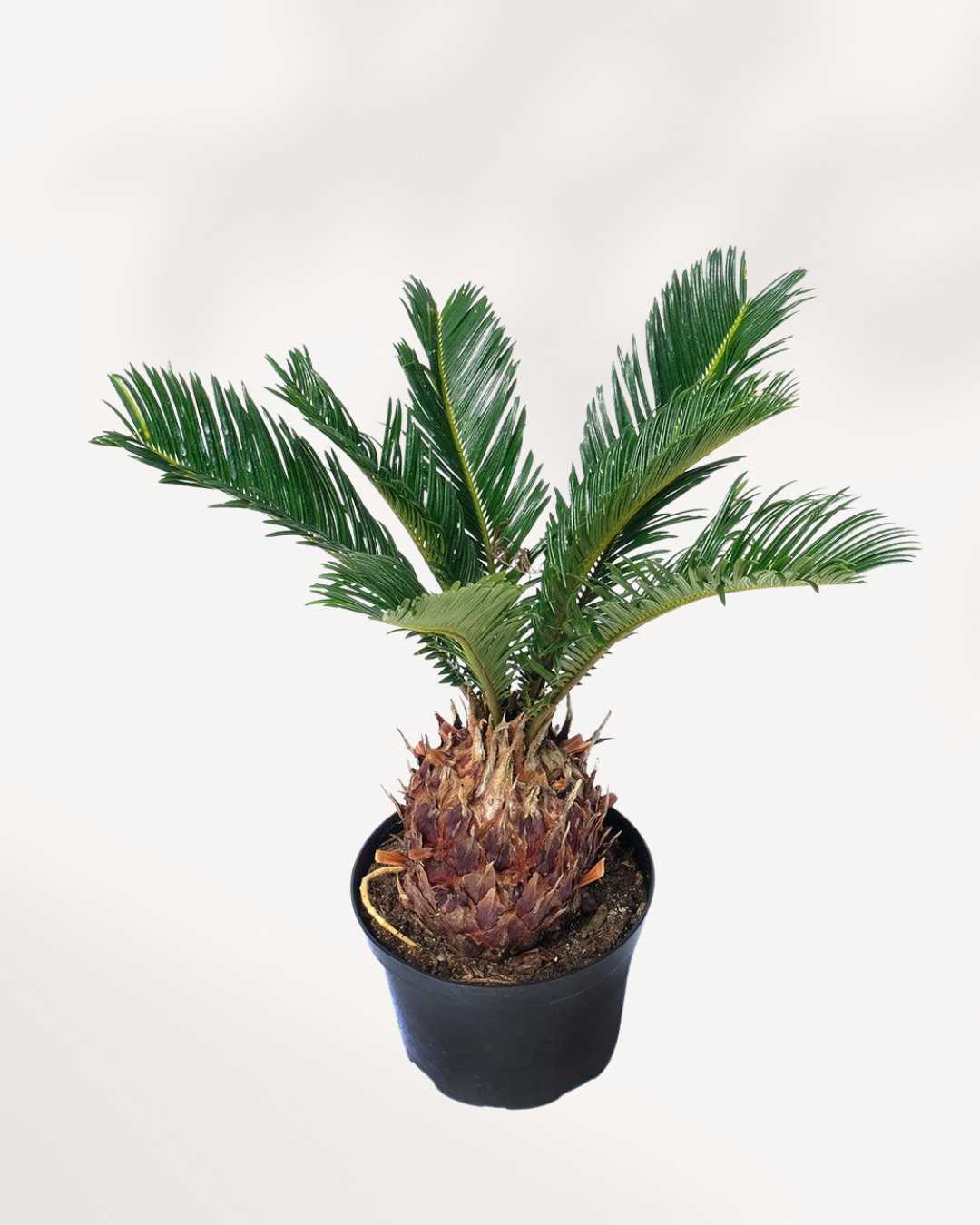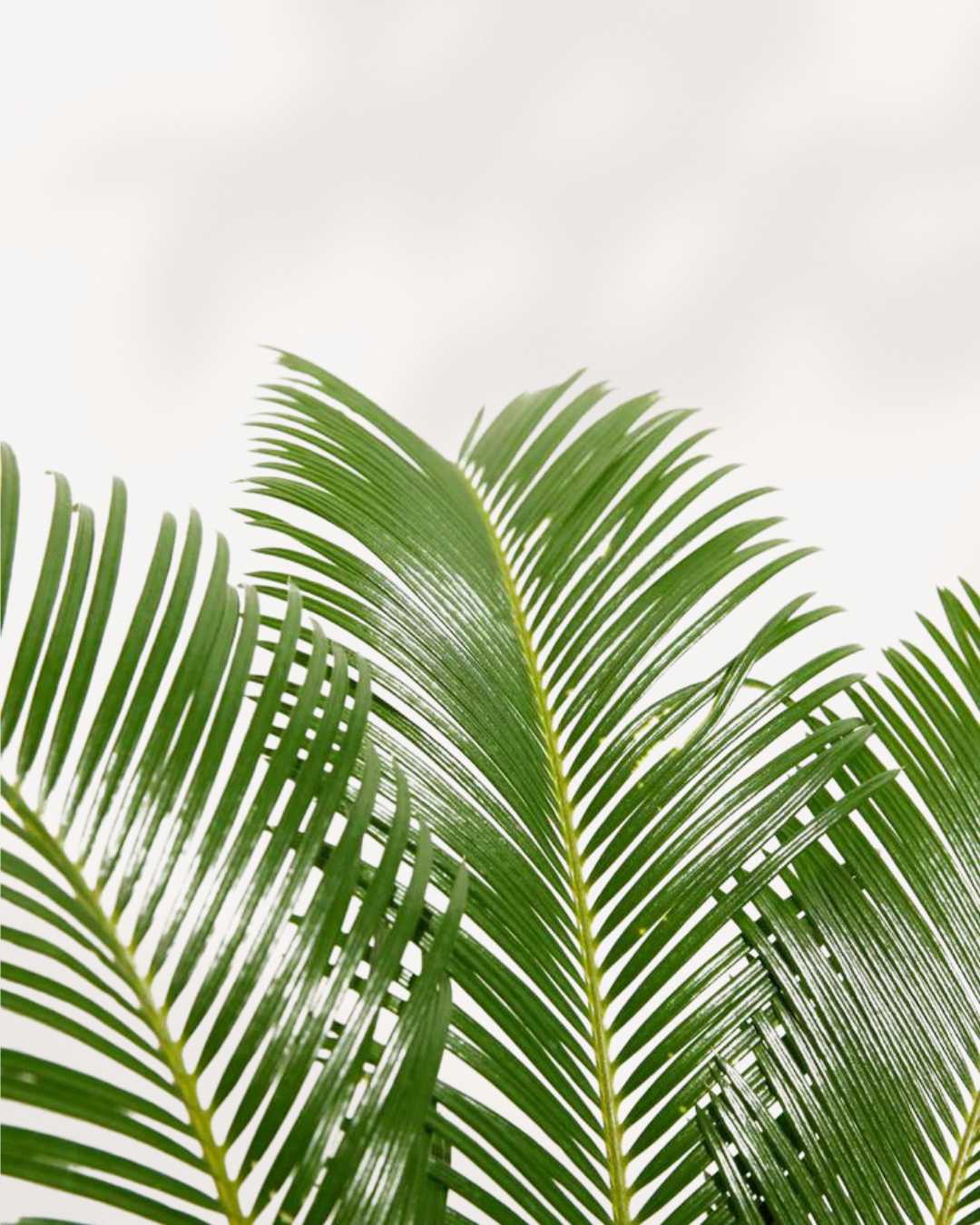Couldn't load pickup availability
Sago Palm, also known as Cycas revoluta, is a timeless and elegant houseplant that brings a touch of tropical charm to any space. Known for its feathery, dark green fronds and symmetrical growth pattern, the Sago Palm adds architectural beauty to indoor and outdoor settings. Despite its palm-like appearance, this plant is actually a cycad, one of the oldest plant groups in the world. Its resilience and slow-growing nature make it a low-maintenance favorite among plant enthusiasts.
Common Names
- Sago Palm
- King Sago Palm
- Cycad Palm
- Japanese Sago Palm
Botanical Classification
- Kingdom: Plantae
- Order: Cycadales
- Family: Cycadaceae
- Genus: Cycas
- Species: Cycas revoluta
Native Habitat
The Sago Palm originates from southern Japan, where it thrives in tropical and subtropical climates. It naturally grows in rocky, well-drained soils, making it well-suited for indoor care when provided with proper light and soil conditions.
Historical and Cultural Significance
The Sago Palm has been cultivated for centuries and is often associated with resilience and longevity due to its ancient lineage. It is admired for its ability to add a tropical aesthetic to both traditional and modern decor styles. In some cultures, it is also regarded as a symbol of prosperity and strength.
Uses and Popularity
The Sago Palm is a versatile ornamental plant commonly used as a focal point in homes, offices, and gardens. Its ability to thrive in containers makes it a perfect indoor plant, while its palm-like structure complements tropical and minimalist designs. Its drought tolerance and low maintenance needs add to its popularity.
Conservation Status
The Sago Palm is widely cultivated and not considered endangered. Its popularity ensures its availability in nurseries and garden centers globally.
Description
Physical Characteristics
Sago Palm features stiff, feather-like leaves that grow in a rosette formation from a central trunk. Its dark green fronds create a dramatic and tropical look, making it a standout in any plant collection.
Growth Habit
This plant has a slow growth rate and can reach up to 6 feet tall indoors with proper care. Its compact size and symmetrical shape make it ideal for tabletop or floor displays.
Popular Plant Varieties
Monstera Dubia
- Known for its climbing habit and shingling leaves that create a lush, tropical effect.
Philodendron Brasil
- Features vibrant green and yellow variegated leaves, perfect for indoor decoration.
Sansevieria Laurentii
- A low-maintenance, air-purifying plant ideal for low-light environments.
Caladium Pink Splash
- Characterized by striking pink and green foliage, adding a vibrant pop of color.
Aglaonema Silver Bay
- Known for its silver-green leaves and adaptability to low light, making it perfect for any home.
Care Guide
Light Requirements
Sago Palm thrives in bright, indirect light but can tolerate partial shade. Avoid prolonged exposure to direct sunlight, which can scorch the leaves. Learn More
Watering Needs
Water sparingly, allowing the soil to dry out between waterings. Overwatering can lead to root rot, so ensure proper drainage. Indoor Plant Watering
Soil Preferences
Use well-draining soil with added sand or perlite to promote proper drainage. A cactus or succulent potting mix works well. Indoor Potting Mix
Humidity
Sago Palm prefers moderate humidity levels but adapts well to average indoor conditions. Mist occasionally if the air is dry.
Fertilization
Feed with a balanced liquid fertilizer during the growing season (spring and summer) to promote healthy growth. Bios Natural Fertilizer
Common Pests
Scale Insects
Scale insects may appear as small bumps on stems and leaves. Use a soft cloth or insecticidal soap to remove them. Learn More
Spider Mites
Spider mites can cause leaf damage by sucking sap. Increase humidity and treat with neem oil or insecticidal soap. Learn More
FAQs
Is the Sago Palm toxic to pets?
Yes, all parts of the Sago Palm are toxic if ingested. Keep it out of reach of pets.
How often should I water my Sago Palm?
Water sparingly, allowing the soil to dry out between waterings to avoid overwatering.
Does the Sago Palm need high humidity?
No, it adapts well to average indoor humidity levels but benefits from occasional misting.
How fast does the Sago Palm grow?
The Sago Palm is a slow-growing plant, typically adding just a few inches of growth per year.
How to take care of Sago Palm
Sun: Direct & Indirect
Sun: Direct & Indirect
Light: Medium - Bright
Light: Medium - Bright
Water: When mostly dry
Water: When mostly dry
Humidity: Any
Humidity: Any
Be cautious with Sago Palm around pets, as it is highly toxic if ingested, posing serious health risks.
Be cautious with Sago Palm around pets, as it is highly toxic if ingested, posing serious health risks.
Pro Tip
Pro Tip
Delivery Policy for Plant Condition
Delivery Policy for Plant Condition
"I have only received part of my order. What to do?
No worries if you've only got part of your order! Our plants come from different nurseries and might arrive in separate shipments, typically 1-2 days apart. It's all part of ensuring your green friends reach you in top-notch condition!
If you do not receive the remaining packages within 48 hours contact support at info@mygreenscape.ca
What is the Life Time Support?
Absolutely! Lifetime support means you can count on us whenever you have questions or uncertainties about your plant. Whether you're puzzled by its behavior or just want to ensure it's thriving, we're here for you. Connect with us on Instagram @mygreenscapeto or shoot us an email at support@mygreenscape.ca.
When it comes to our guarantee for plants shipped with standard or express, rest assured that we offer a 30-day happy healthy plant guarantee on all such shipments. This ensures that your plants are covered for 30 days after delivery, giving you peace of mind regarding their condition. If you have any concerns within this period, feel free to reach out to us for assistance.
For further details, please visit our Local Delivery, Store Pickup, Standard Shipping Guide Page.
What to expect
What to expect
Your plant will arrive in a standard nursery pot, typically 0.5" - 1" smaller than the stated size to seamlessly fit into your chosen decorative pot. Washable Paper Planter Bags are available for separate purchase.
Just like nature intended, each plant is unique, showcasing natural variations in size, shape, and characteristics. Our commitment is to deliver a plant that closely resembles the one featured on our website, matching your chosen size, and with the potential to thrive happily in your home.
Frequently Asked Questions
Frequently Asked Questions
Certainly! If you're pondering about ordering plants online, you're not alone. We've compiled the most frequently asked questions. Check out our FAQ section here for quick answers! Happy planting!
Plant & Pot Size Chart
Plant & Pot Size Chart
Choosing the right pot size for your plants can be a daunting task, especially if you're new to gardening. But fear not! Our pot sizes chart can help you find the perfect match for your plants, ensuring they have enough space to grow and thrive. With our guide, you'll be able to confidently choose the right pot size and plant variety for your gardening needs.
Plant Pot Size Guide.

| Extra Small | 7-10 cm | 2.5 - 3 inches |
| Small | 11-12 cm | 3.5 - 4 inches |
| Medium | 14-17 cm | 5 - 6 inches |
| Large | 19-21 cm | 8 - 10 inches |
| Extra Large | 24-27 cm | 12 - 14 inches |
All sizes are specified in product details.
Your Complete Guide to Pot Sizes: What Size Should You Choose?

When selecting a pot for your plant, it's important to find the right size. But with all the different options out there, how do you know which one is best? We're here to help!
MyGreenscape's pot sizes chart is a great resource for finding your perfect fit. Our easy-to-read chart takes out all the guesswork and helps you quickly choose the right size for your plant.
Smaller pots are best for seedlings or small plants just starting out. These tend to be shallow but wide, allowing enough room for the roots of the young plant but not too much where they get overcrowded. Medium-sized pots are ideal when your plant has grown from its infancy and is ready for more space. These are deeper and wider than small pots, so that it can accommodate larger root systems - making sure your plant gets enough nourishment while still giving it breathing room. Large pots are top choice if you have an established plant in need of lots of space - think trees and large shrubs! The spacious depth and width allow plenty of room for deep root systems without struggling for air or light.
No matter what size you choose, MyGreenscape has got you covered, with our pot sizes chart guaranteeing you find the perfect fit every time!
Winter Shipping Protection
Winter Shipping Protection
We take extra care with each package during the colder months. For destinations experiencing cold weather, we provide insulated packaging and heat packs as needed to protect your plants from freezing temperatures. With Winter Shipping Protection, your plants are equipped to arrive safe and sound, even in winter’s chill.
Care Guide
Care Guide
Explore essential care tips. check out our Comprehensive Resource for Indoor Plant Care.


WATERING MADE EASY
Check soil moisture before watering and use a potting mix that drains well. It’s the secret to healthy, happy plants!
Hear From Happy Plant Parents.
Who have brought Mygreenscape plants into their homes.














